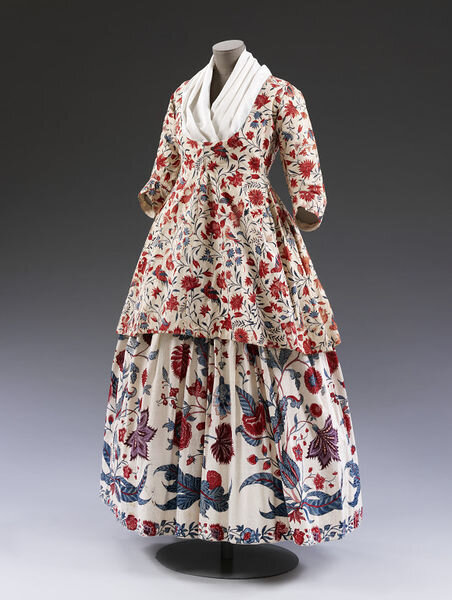Fashion and Colonialism: a Case Study of India
Written by: Caroleen Molenaar, Research and Content Coordinator
[7-minute read]
The relationship between fashion industries and colonialism is deeply intertwined within history and the present day. Despite many colonies having been eradicated, such as in India, Malta, Brazil, Indonesia, and Jamaica among many others, the lasting effects of colonization still remain in many of these countries. To dive into these complex relationships, India will be used as the main case study.
To provide a brief historical outline, the colonization of India took place with several overlapping stages by varying countries between the beginnings of the 1600s and the mid-1900s. Colonizers of India include the Portuguese and the British (the primary colonizers) with the Portuguese East India Company, and the East India Company respectively, and the Dutch, the Danish, and the French (the secondary colonizers) with the Dutch East India Company, the Danish East India Company, and the French East India Company respectively. One of the main intentions behind colonization, aside from conquest, was the trading and exporting of goods for the benefit of the colonizers and their respective countrymen and women. Indian spices were one of the main items being purchased and traded, but Indian textiles were also valued highly and were purchased and traded by European colonizers.
Figure 2. Chintz petticoat and jacket, circa mid 18th century, Victoria and Albert Museum, London, UK. Object number: IS. 14-1950.
As colonization progressed, India-made textiles began influencing Europe with the introduction of chintz: a calico hand-blocked or printed textile that was easily identifiable by its red, green and/or blue dyes and nature-influenced themes of vines, leaves, birds, and/or flowers. The use of chintz textiles in Europe were initially seen on bed hangings, curtains, and upholstery.
In the 21st century, the definition of chintz has been altered to be associated with slightly tacky or vulgar floral patterns that are printed on wallpaper, curtains, or upholstery, without the historical knowledge that the origins of the word are rooted in colonization, and trade. By the mid-1600s the red, green, and/or blue nature-inspired chintz calico patterns soon began to influence European women’s fashions. Dresses, skirts, and bodices, among other fashion items, were made with these patterns and were worn by varying classes in different countries.
Figure 4. François Hubert Drouais, Madame de Pompadour at her Tambour Frame, 1763-4, National Gallery, London, UK.
Figure 3. Richard Powers, Chintz decorated room, from “Like it or not, Chintz is making a Comeback in the World of Design”, Elle Decor. 17 September 2015.
In France, chintz was initially worn by the aristocracy, as seen in paintings, but in Spain and England, chintz was typically worn by lower classes, until the aristocracy began adapting their wardrobes in the 1670s.[1] Due to the complaints of European textile makers about the importance and creation of local and national textiles, which at the time were hemp, wool, and silk, European countries began banning the import of chintz to refocus on European-made textiles. Chintz was fully banned in France between 1686 and 1759, partially banned in England between 1700-1774, and its imports to other countries, including Spain, Prussia, and the Republic of Venice, became highly regulated.[2] By the 1700s, European textile manufacturers began producing chintz independently in Europe, which led to Britain becoming one of Europe’s leading textile manufacturers (despite Britain still relying on reduced cotton imports from India). Over time, the popularity of chintz began to wane in Europe, and by the 19th century it fell out of fashionable favour. Today, the use of chintz as a textile for clothing still re-emerges as seen in the works of designers by Alexander McQueen’s Sarah Burton, Cath Kidston, and Richard Quinn, although the original colour palettes of red and green have largely expanded (and now encompass any colour) due to the evolutions of fabric dyes and printing technologies.[3]
Figure 5. Image of garment workers in Bangalore, India, from ““We cannot talk about it”: Factory workers for major fashion labels live confined by guards,” Quartz. 29 January 2016.
In the present day, although the European and colonial rule over India has ended, there are still underlying colonialist systems still in effect. One example can be seen where many Indian garment workers (notably women and children) are employed by factories and suppliers to create textiles and garments for European and American fashion companies, including H&M, Zara, American Eagle, plus many more. One can argue that the business arrangements currently in place parallel the chintz era, as described above, where Indian workers had to create textiles and garments to support the demand in the West. Unlike the past European efforts to maintain the production of their own textiles and garments, the huge and growing impacts of globalization in the past 20 to 30 years has made it cheaper for many Western countries to outsource the creation of clothing from the cheapest maker – typically those that are located in Asian countries. This has resulted in a growing amplification of the ongoing problems surrounding the treatment of garment workers, as growing demand to find cheaper clothing production continues to result in lower wages, the sacrifice of safe working conditions, the poor treatment of the garment workers, and the overall disregard for human rights.
Despite the ongoing poor treatment of many Indian garment workers, there is a light at the end of the tunnel. Global recognition is being made by consumers and producers alike, as well as by innovative and driven organizations like Threading Change, Fashion Revolution, Labour Behind the Label, and many others, who are fighting to end labour exploitation in the fashion industry, not just in India, but across the world.
Author Notes:
1. For clarification, the reference of ‘Asia’ includes all Asian countries within the Asia continent.
2. It is challenging to compare 21st century India to India in the 1600s and 1700s due to numerous factors including, but not limited to, colonization and technological innovations, but I hope that the conceptual similarities still emerge within the blog post
3. It is worthy to note that this blog post only scratches the surface of the history of colonization, India’s history, chintz, and the fashion industry. For more information on the variety of topics mentioned please visit:
Fashion Revolution: https://www.fashionrevolution.org/
Labour Behind the Label: https://labourbehindthelabel.org/
Additional Resources
Chintz:
Indian Textiles: Trade and Production: https://www.metmuseum.org/toah/hd/intx/hd_intx.htm
Indian Chintz: A legacy of Luxury: https://www.vam.ac.uk/blog/fabric-of-india/guest-post-indian-chintz-a-legacy-of-luxury
The Fabric of India: Textiles in a Changing World:http://www.vam.ac.uk/content/exhibitions/the-fabric-of-india/textiles-in-a-changing-world/
About the Author
Caroleen is a versatile researcher, writer, and editor who specializes in fashion and dress history in the areas of late 19th century fashions, Canadian fashion history, decolonization in fashion, and ethical and sustainable fashion. Having completed an undergraduate degree in Fashion and Dress History at the University of Brighton, UK, and a graduate degree in Museum Studies at the University of Leicester, UK, Caroleen is excited to find ways to share with audiences the hidden, detrimental, and positive aspects of the fashion industry and its histories. Since 2020 she also volunteers for the Association of Dress Historians, London, UK, as a Digital Communications Assistant.
References:
[1] Bekhrad, Joobin. “The Floral Fabric That was Banned”, BBC: The Collection. 21 April 2020. Accessed 24 May 2020. https://www.bbc.com/culture/article/20200420-the-cutesy-fabric-that-was-banned
[2] Ibid.
[3]Ibid.





